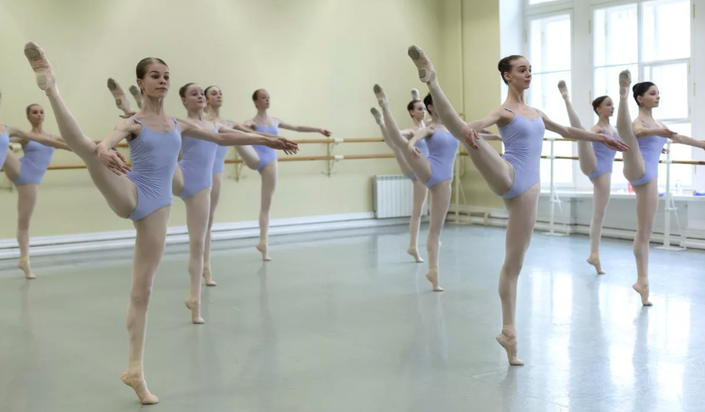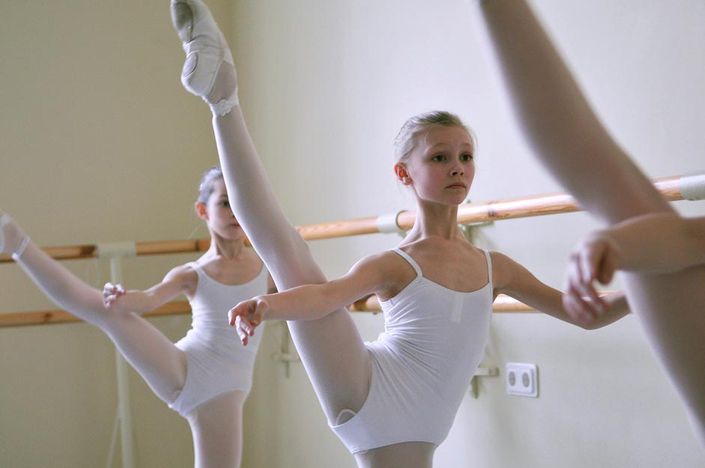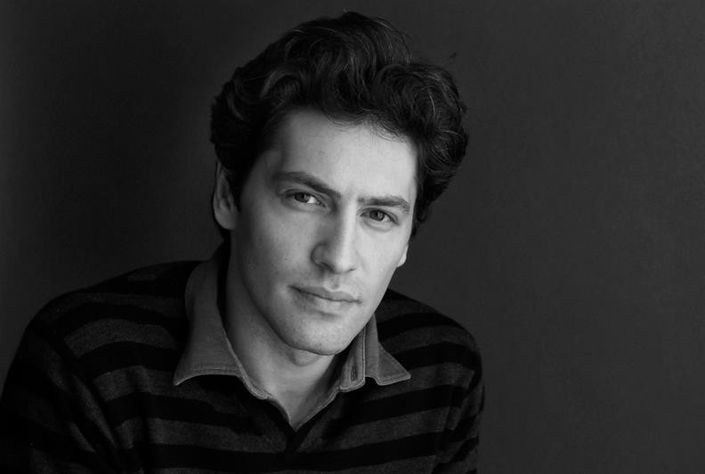

Maurizio Bendandi- Learn Ballet Online Students
This resource provides a traditional introduction of the second year of Vaganova Ballet Syllabus for dance teachers and dance students. With its highly specialized technique and dynamic history, Vaganova Ballet system can seem inaccessible. This Vaganova Ballet Syllabus aims to demonstrate that the underlying principles of the first year in ballet education are founded on basic movement. This resource focuses on key movement principles of ballet, rather than specific steps and emphasis on correct placement, alignment and épaulement, seeking always to allow these to arise through a developing sense of movement. In the first year, the basic skills are introduced. The forms of the steps and slow tempos are an excellent way of developing the use of the body, legs and feet. Concentration of the first year exercises of Vaganova Ballet Syllabus is characterized by a particular musicality, precision of movement, and clarity of line. Within the steps it’s emphasized to find the efficiency and deep physical experience of which the body is capable, through this highly developed training system.
WHAT IS RUSSIAN VAGANOVA BALLET TECHNIQUE? WHAT MAKES IT DIFFERENT?
People often ask about Russian Vaganova Ballet Technique and training; what is it exactly that makes it unique? Vaganova training is the purest form of teaching classical ballet. It is a thorough and methodical technique, which allows the dancer to learn the proper use of muscles with control, strength and grace, without introducing tension or overuse of the wrong muscles. Vaganova Ballet Technique was developed by Agrippina Vaganova (1879-1951) a distinguished Russian ballet dancer, choreographer and teacher. She danced professionally with the Mariinsky Ballet in St. Petersburg. She became known as the "Queen of Variations" for her brilliant solos. As a dancer, she was extremely self-critical and aware of her inadequacies of her own technique. When she retired from dancing to become a teacher, she became more and more conscious of her desire to investigate the “science of ballet,” to find effective means of training classical dancers. Through studying the French, Italian, Danish and Russian methods, Vaganova designed a training method and began to produce a few dancers. At the age of 17, these dancers were catching the attention of the critics who were astonished by the rich orchestration of their movements, brilliance of their turns, and the unusual expressiveness of their arms. Gradually, more dancers were produced through Vaganova technique. This, in turn, affected the performance quality of the classical ballets, such as Swan Lake and Esmerelda. The performance style of the dancer was strengthened and polished, from the girls in the corps de ballet to the leading ballerinas. Something they had in common was their manner of execution, a single style, a single dance "handwriting," which manifests itself clearly in their harmonious plasticity of movement, the expressiveness of their arms, suppleness (yet at the same time the iron aplomb of the body), and the noble and natural placement of the head. Vaganova’s method also influenced the development of the male dancer; helping them find the iron aplomb and stability that enabled them to find support in their body to provide the strength for turns and jumps. These are the distinctive traits of the Vaganova technique. Some key techniques Vaganova incorporated into her teaching method are:
- Special attention to epaulement (turning of the shoulders and upper body)
- Correct training of the arms (port de bras), fluidity, placement, coordination with the head and all movements
- Precise coordination of the whole body, working as one unit
- Unique sense of musicality (Russian-style pianist class accompanist)
Vaganova’s system aimed at teaching students to “dance with the whole body.” The systematic design of the classes carefully teaches the technique without room for error or bad habits to develop. The exercises naturally progress and are easily executed by teaching the correct muscles to respond to the movement. The technique naturally allows the dancer to progress to the next level of movement easily and free of tension or lack of control. The Syllabus moves at an appropriate pace to carefully train the young dancer, which compliments their age and rate of growth, so that by the age of 17, the dancer is properly equipped to go onto further pre-professional study.
Get started now!
Course Curriculum
-
Start1. Big and small poses: croisée, effacée, ecartée front and back (6:08)
-
Start2. a.b.c Battement Tendus (5:38)
-
Start3. Battement Tendu Jeté (3:00)
-
Start4. Demi-round de jambe and round de jambe in 45º (4:31)
-
Start5. Battement fondu (3:57)
-
Start6. Battement soutenu (1:39)
-
Start7. Battement frappés on relevé (1:54)
-
Start8. Battement doubles frappés on relevé (1:16)
-
Start9. Petit Battement sur le cou-de-pied (2:14)
-
Start10. Flic front and back on flat and with relevé (1:59)
-
Start11. Pas tombé: a,b (1:47)
-
Start12. Pas coupé on relevé. (1:43)
-
Start13. Rond de jambe en l'air en dehors and en dedans on relevé (2:37)
-
Start14. Petit temps relevé en dehors and en dedans on flat foot with the end on relevé (2:47)
-
Start15. Battements relvés lents and battements dveloppés: (4:02)
-
Start16. Demi-rond de jambe and grand rond de jambe. (2:52)
-
Start17. Grands battements jetes: a,b,c (3:14)
-
Start18. Relevés a,b (3:28)
-
Start19. 1st and 3rd port de bras with leg (3:46)
-
Start20. Turn fouette en dehors and en dedans (4:41)
-
Start21. Soutenu en tournant en dehors and en dedans. (3:28)
-
Start22. Half turns on one leg en dehors and en dedans. (4:49)
-
Start23. Pirouette en dehors and en dedans in V (2:53)
-
StartQuiz Barre
-
PreviewIntroduction
-
Start1. Big and small poses: croisée, effacée, ecartée front and back (2:56)
-
Start2. Grand plié (3:15)
-
Start3. Battement Tendus (3:37)
-
Start4. Battements tendus jeté: (2:05)
-
Start5. Rond de jambe par terre en dehors and en dedans in demi-plié (3:41)
-
Start6. Demi-rond de jambe and rond de jambe (2:44)
-
Start7. Battements fondus (3:26)
-
Start8. Battements soutenus en face in small postions (5:06)
-
Start9. Battements frappes small postions (1:57)
-
Start10. Battements doubles frappés small postions (2:13)
-
Start11. Petits battements sur le cou-de-pied (2:50)
-
Start12. Rond de jambe en l'air en dehors and en dedans. (1:40)
-
Start13. Petit temps relevé en dehors and en dedans. (1:46)
-
Start14. Flic front and back on flat (2:16)
-
Start15. Pas tombé in place. (1:06)
-
Start16. Pas coupé on flat foot and on relevé, other leg 45º (3:30)
-
Start17. Battements relevés lents and battements développes: (1:16)
-
Start18. Demi-rond de jambe and grand round de jambe in 90º en dehors and en dedans, en face. (1:16)
-
Start19. Grands battements jetés: (1:48)
-
Start20. 4th and 5th port de bras (2:23)
-
Start21. Temps lié par terre with bend of body (2:32)
-
Start22. Pose IV arabesque with a foot into the floor (1:31)
-
Start23. Relevés (3:36)
-
Start24. Pas de bourré: (2:29)
-
Start25. Preparation to pirouette en dehors and en dedans (3:04)
-
Start26. Pirouette en dehors and en dedans with... (1:15)
-
Start27. Pas jeté ( piqué) (3:12)
-
Start28. Soutenus en tournant en dehors and en dedans.. (3:17)
-
Start29. Glissade en tournant en dehors and en dedans... (3:49)
-
Start30. Turn fouetté en dehors and en dedans in... (2:27)
Your Instructor

About Us and our team. The reason we have launched "Learn Ballet Online" is because Ballet is a very complex and difficult art form. It is hard to understand until you start executing it. It is a multidimensional activity, involving physical, emotional and psychological elements. We do not believe that you can learn Ballet movements online, but you can learn the theory and comprehend how those movements are executed. Muscle memory can be a blessing and a curse - if you take a couple classes and learn incorrect technique, it will be very difficult to change! But, if you can understand the proper placement of your limbs and muscles, with the help of your teacher, your mind and body can guide you in the right direction.
No matter what style of dance you do, it is critical to train your body properly and practice correct technique to avoid injury. There is no instant gratification. Ballet is a process, a journey that you must be ready to take.
Whether your goal is to become a professional dancer, or to practice for your own enjoyment, taking our courses will offer you an opportunity to learn in-depth execution of classical steps. These steps are explained in accordance to a syllabus. Each lesson is crafted with instructions for execution of specific ballet combinations.
Frequently Asked Questions
Get started now!
Featured Courses




